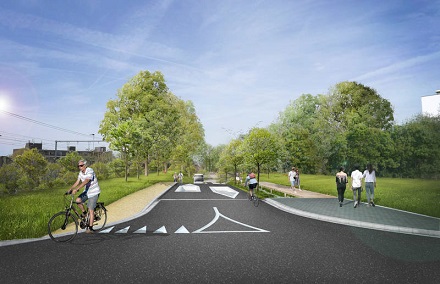Rue du Wagon- Wagenstraat
Development of rue du wagon
The planning permit request concerns the extension/creation of Rue du Wagon as a lane reserved for public transport (buses), cyclists and pedestrians (except local access to building car parks).
Bus Master Plan
Following the implementation of the Bus Master Plan (approved by the government at second reading on 21 March 2018), rue du Wagon/Wagenstraat will be used by bus lines 41 and 74, which will connect the two main roads (rue de Stalle/Stallestraat and chaussée d’Alsemberg/Alsembergsesteenweg), as well as providing the link that is currently missing between the station and the “lower” part of the neighbourhood. From the station, connections with various bus and tram lines will increase the range of connections from this point of entry to the Brussels Region.
Project objectives
The extension of rue du Wagon/Wagenstraat has a number of key objectives:
- to implement the Bus Master Plan,
- to improve accessibility to Uccle-Calevoet/Ukkel Kalevoet station for active modes of transport,
- to improve the distribution of mobility by creating a better pedestrian and cycle connection between Uccle Calevoet/Ukkel Kalevoet station and the rue de Stalle/Stallestraat business and services area,
- to improve the commercial speed and regularity of buses between Uccle Calevoet/Ukkel Kalevoet station and place Danco/Dancoplein.
- It will also enable buses to avoid the section of the chaussée d'Alsemberg/Alsembergsesteenweg between Uccle-Calevoet/Ukkel-Kalevoet station and Globe, where buses operate at speeds of less than 10 kph.
In addition, the project aims to:
- return to a more balanced and diversified use of public space,
- make it more user-friendly, in line with local activities, and make it a prime location for active mobility: pedestrians, cyclists, people with reduced mobility, access to the various points of interest (schools, public transport, cultural, sports and leisure facilities, etc.),
- enhance the value of the architectural heritage,
- ensure road safety (traffic and speed control),
- provide safe cycle paths and itineraries,
- organise parking for residents and visitors,
- make this project an outstanding example of stormwater management.
The overall aim is therefore to improve the quality of life for residents and users of the neighbourhood and public transport, and to make public spaces more user-friendly, while at the same time making them accessible to commuters heading for the office, business, shopping, school and transport areas.
